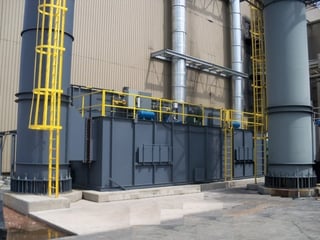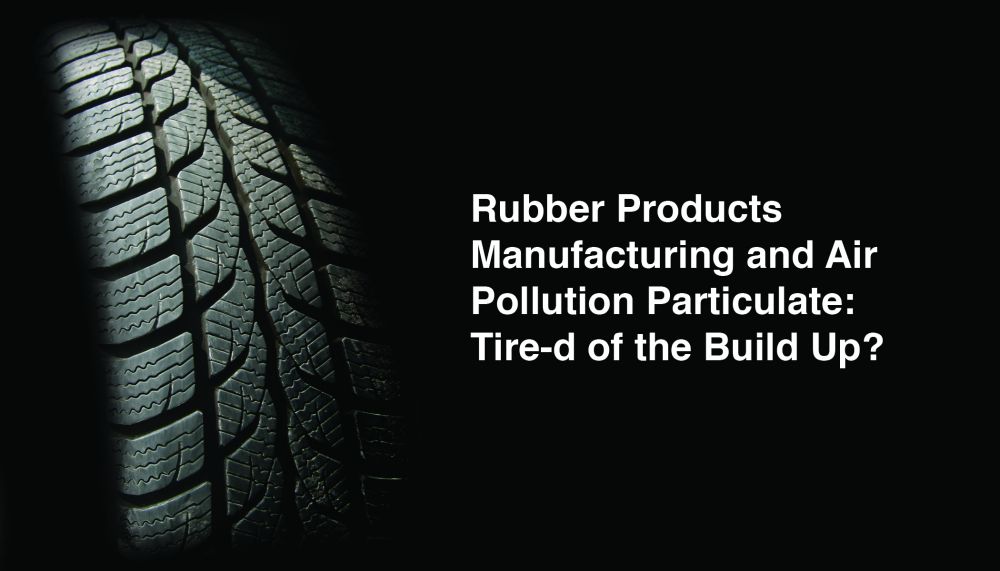Industrial manufacturing companies, such as the tire and rubber manufacturing industry are striving for maximum uptime of their process manufacturing equipment. It is vital that unplanned downtime is kept to a minimum, and maintenance intervals can be predicted to match the scheduled downtime of each individual facility. This is especially true with your air pollution control equipment which is essentially the “permit to operate” the revenue generating portions of your manufacturing process. Don’t let the stress of untimely and costly downtime build up, literally.
This case study will focus on particulate build up in your Regenerative Thermal Oxidizer (RTO).
We walk through many challenges that come with the high expectations of optimal uptime in the tire and rubber manufacturing industry and the potential for particulate build up when manufacturing rubber products in particular but are also applicable to most industrial processes as well.
Particulate Build up
When producing rubber for new light or heavy-duty vehicles, such as automotive, truck, or motorcycle tires, there are many chemicals that are mixed together. From these mixers, there is often Ethanol and other Volatile Organic Compounds (VOCs) which are emitted during the process to create various formulations of rubber. The production process generates a significant amount of particulate, which is routed to a particulate collection system, typically a baghouse. From the baghouse, the process exhaust is directed through a duct work system to an air pollution control device, typically a Regenerative Thermal Oxidizer (RTO).
Baghouses provide good uptime reliability, but from time to time bag breaks will occur and potentially go undetected for a period of time allowing some of the particulate into the airstream of the RTO system. The particulate that moves past the bag house which is organic can typically be burned off during a bakeout cycle, but the inorganic particulate cannot be baked out and will build up over time inside the RTO heat exchanger. In these situations, some of the inorganic particulate may pass all the way through the system, however a portion will eventually build up within the heat exchanger leading to reduced thermal effectiveness, higher pressure drops, and eventual loss of airflow capacity. Each of these symptoms can lead to inefficient operation and potential compliance issues that will dictate unplanned downtime.
A Regenerative Thermal Oxidizer (RTO) is typically the preferred oxidizer tec hnology in rubber manufacturing because of the relatively low VOC concentrations within the process emissions and RTO’s are generally the most thermally efficient thermal oxidizer. To achieve the higher thermal efficiencies, an RTO utilizes heat exchangers which are ceramic based, however they are not able to be thoroughly cleaned once the particulate accumulates. The goal is to eliminate the particulate before the RTO system as much as possible, which results in a financial trade-off between the upstream filtering redundancy necessary to control particulate versus maintenance intervals requiring media change out.
hnology in rubber manufacturing because of the relatively low VOC concentrations within the process emissions and RTO’s are generally the most thermally efficient thermal oxidizer. To achieve the higher thermal efficiencies, an RTO utilizes heat exchangers which are ceramic based, however they are not able to be thoroughly cleaned once the particulate accumulates. The goal is to eliminate the particulate before the RTO system as much as possible, which results in a financial trade-off between the upstream filtering redundancy necessary to control particulate versus maintenance intervals requiring media change out.
A Proactive Approach to Particulate
Catalytic Products International (CPI) has taken a novel approach to applying a Regenerative Thermal Oxidizer (RTO) to this application. This approach understands that particulate may be unavoidable, therefore the design allows for the particulate to be moved through the Regenerative Thermal Oxidizer (RTO) or collected in areas that are easily serviced during planned maintenance periods. This specific ceramic heat exchanger design minimizes the typical areas where plugging occurs, including areas designed for accumulation of the particulate and provides easy access for clean out. This reduces the potential for emergency outages, and reduces planned maintenance downtime. CPI understands the sense of urgency all customers operate their businesses with, dictating the need for reliable equipment and uptime between maintenance intervals.
Updating the design of the ceramic heat exchanger alone is not enough to the ensure the confidence needed for long term operation. The Regenerative Thermal Oxidizer (RTO) must also include advanced controls which recognize and predict existing and future issues with the heat exchanger and other system components as soon as possible. The data collected with advanced controls will help diagnose upcoming issue and allow for planning a corrective action during the next scheduled maintenance interval.
If you are looking for the proactive solution to particulate build up inside your Regenerative Thermal Oxidizer (RTO) which will help to limit downtime for maintenance and to avoid emergency shut downs of your production operations, speak with one of our applications engineers today.








